One of the basic and crucial thing to learn about fishing is casting. Many beginners, in their initial phases, wonder how they can cast accurately or I should say, the right way. Well, if you get hold of a few concepts, I’m sure casting won’t be much of a big deal for you.
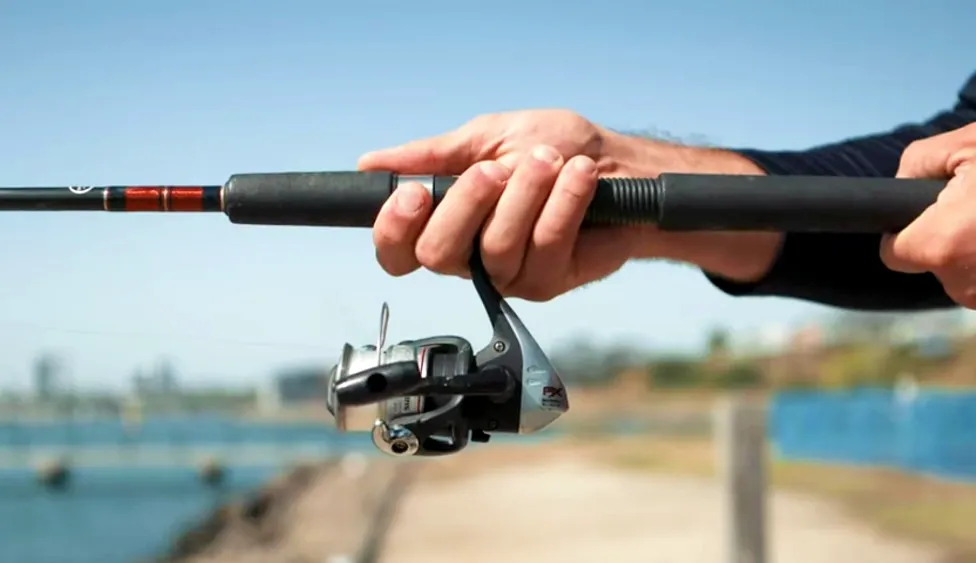
The first rule of learning is not to focus on the results but on the learning process. Your goal should always be to learn. It doesn’t matter if you are making mistakes along the way. These mistakes will help you become a better angler. This is what casting is all about i.e. to focus, which I’m sure you can.
So, What is casting?
When you find this term in fishing, it refers to the act of throwing the bait and hook along with other fishing tackles, by slinging the fishing line with the help of your fishing rod, out over the water. The elasticity and the length of your rod along with the slinging capability of your fishing line are the two major things involved in the casting process.
Why is it important to cast accurately?
There is no standard way of doing anything. However, there are some basic steps that we have learned throughout the ages to enhance our fishing expeditions. So, missing them means that you are missing out on a better fishing experience. So, to cast accurately is important as an angler.
1) When you are aware of the accurate casting techniques, you can target the specific areas of your own choice. Wherever you are, you can cast accurately and precisely which helps you in reaching the target fish easily.
2) During fishing, you will often come across obstacles like rocks, logs, underwater fishing vegetation, etc. These obstacles can cause you a lot of trouble by snagging your line or lure. When you are aware of the right way to cast, you can dodge such obstacles.
3) Some fish are known to be very cautious. To lure them easily is not possible. For that, you have to be good at casting accurately so that you can present your bait more naturally.
4) Accurate casting allows you to reduce disturbance on the water surface. This way your presentation looks very less suspicious to the fish. This is very important when you are hunting intelligent fish like trout or bass.
5) With the help of casting, you can try different fishing techniques effectively. This opens up a lot of opportunities for you to excel in different fishing styles.
6) Most importantly, when you know how to cast, you can save your time and energy. You don’t have to repeatedly retrieve and recast during your fishing trip.
How to cast a fishing rod?
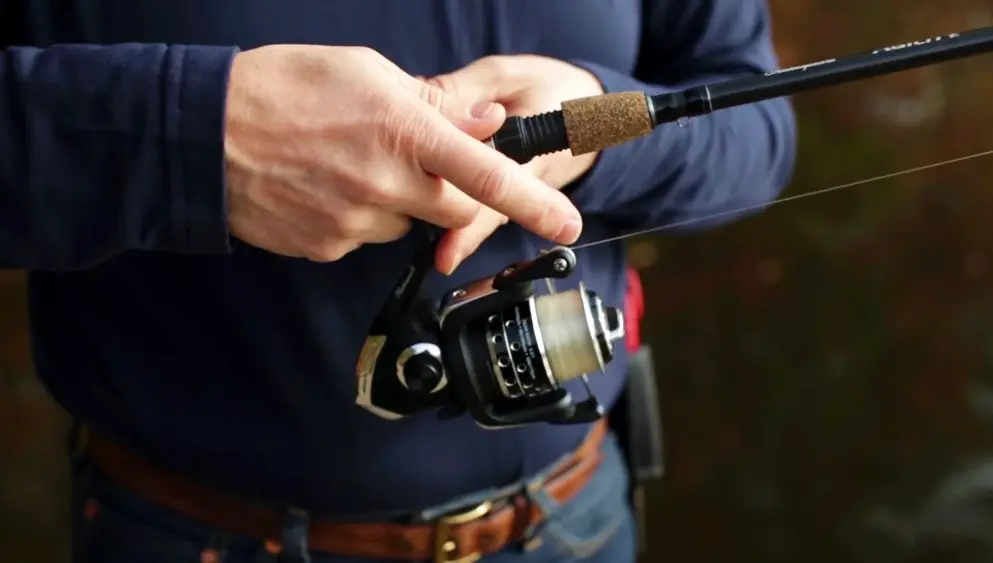
When it comes to casting, there are typically four major steps that you have to keep in mind before starting. These steps will help you further in understanding how different reels work with casting.
Preparing your setup:
Whenever I have to jolt down steps fordoing any fishing activity, the first thing I always stress is the preparation. Make sure that your rod and fishing gear are in good condition. Attach the reel, thread the line, and secure your bait with an appropriate knot.
The right stance and grip:
Your position plays an effective role in angling. There are factors like wind, obstacles, the fish location, etc, that you have to keep in your mind. You have to hold your fishing rod with a firm and comfortable grip using your dominant hand above the reel and the other further up the rod for stability.
The casting motion:
To begin with the casting motion, you have to load first. Loading, in angling, refers to the building up of energy in the rod that is transferred to the bait or lure during the cast. You first have to raise the rod tip towards your eye level and then accelerate it forward, towards the direction of your target. Releasing the bait or lure at the right moment then allows your line to flow freely, carrying your bait to the desired location
Control:
After casting, it isn’t over. You have to continue the forward motion of your rod slightly beyond there lease point so that the line flows smoothly. With the help of the reel’s bail, you have to maintain your control over the line. You have to be mentally present during this as at any moment, the target fish will bite and you will have to reel in.
Casting with different reels and rods:
Now that you have a basic idea of what casting is all about, let us move toward different kinds of reels and rods that you will come across. They all have a lot of similarities, so learning them won’t be that much of a big deal.
Casting with a spinning reel:
Casting with a spinning reel makes use of the weight of the lure or bait to move your line. The quality of your spinning rod is quite essential. It will ensure that your fishing experience is simple and enjoyable. To begin, the fishing line you use is critical to your fishing experience. It would help if you also experimented with different braid styles. Braids will let you cast your line further than monofilaments or fluorocarbon. This is because the diameter is narrower and is more inclined to spring off to a spool.
What you should use?
Inshore applications should typically use a 10 to 15-pound test line. This is useful if you are concerned about casting fake lures or simply about receiving the best range. The lesser diameter of 15 pounds would operate well and smoothly. Keep in mind that the smaller your spinning wheel, the smaller your spool will be. This means that the line would depart the spool slowly from your tiny spinning wheel. Whereas with a larger wheel, the line would quickly escape the spool. Make sure your rod is springy and flexible as it allows you to cast more effectively and cover greater distances.
Step#1
The first thing you should think about is the wind’s direction. Check that the wind is blowing in the direction you intend to cast. This will allow you to cover more ground with your fishing pole. When you set up your cast, make sure your lure is 6 to 12 inches away from your tip. This will assist you in gaining momentum for casting, and the lure will fly, appropriately loading the rod.
Step#2
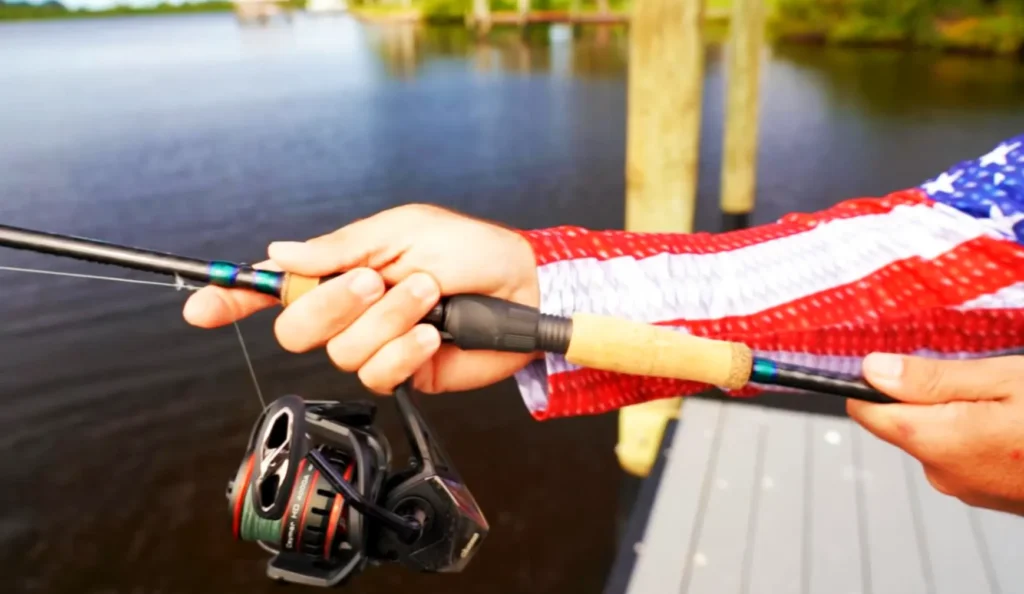
With your dominant hand, wrap your fingers around the rod handle and place your thumb on top. Your grip and your posture matter a lot, so make sure that your grip is comfortable.
Step#3
Check that the bail (the wire arm that flips open and closed on the reel) is in the closed position.
Step#4
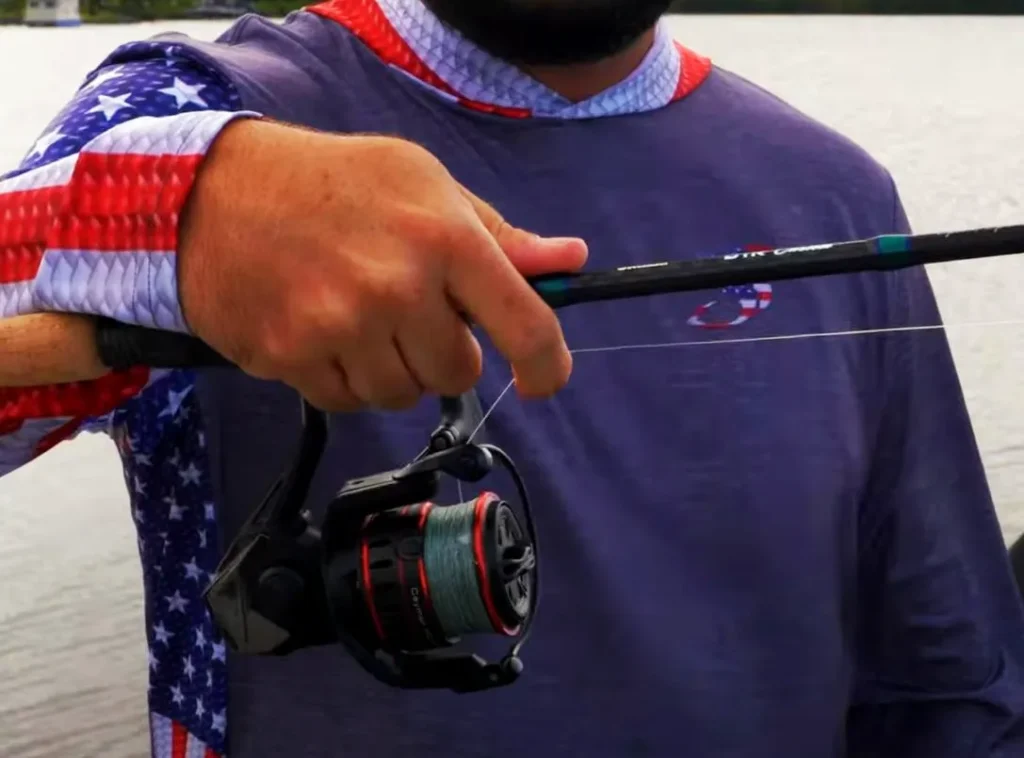
Hold the line directly above the reel with your non-dominant hand, lightly squeezing it between your fingers.
Step#5
Maintain a shoulder-width distance between your feet and face your target region. At a 45-degree angle, point the rod tip downward and slightly to the side.
Step#6
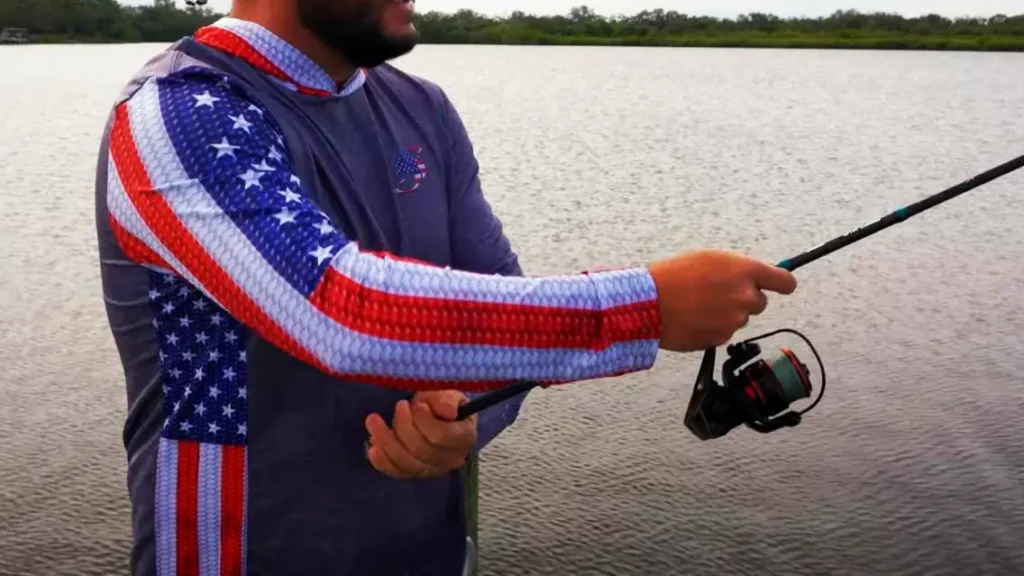
Swing the rod tip up and down in a smooth, controlled motion to develop velocity. Release the line from your non-dominant hand’s grasp as the rod tip advances to around eye level. This should allow the line to exit the reel easily.
Step#7
Now, you have to release. As the line begins to flow, position the rod tip towards your target region and keep moving ahead. The line should unspool at the end of the casting motion, carrying your bait or lure to the desired position.
Step#8
When your bait or lure has hit the water, engage the bail by flipping it closed. Begin reeling in slowly while keeping the strain on the line.
Step#9
Casting a spinning rod requires practice to perfect the timing and accuracy. Begin with short casts and work your way up to longer distances.
Note: To enhance your casting talents, remember to be patient and practice consistently. Depending on your fishing conditions and intentions, different lures and baits may necessitate modest modifications in your casting method.
Casting with a bait caster:
Casting with a bait caster rod differs from spinning rod casting and takes some practice to get the hang of. Here’s an overview of how to cast a bait caster rod:
Step#1
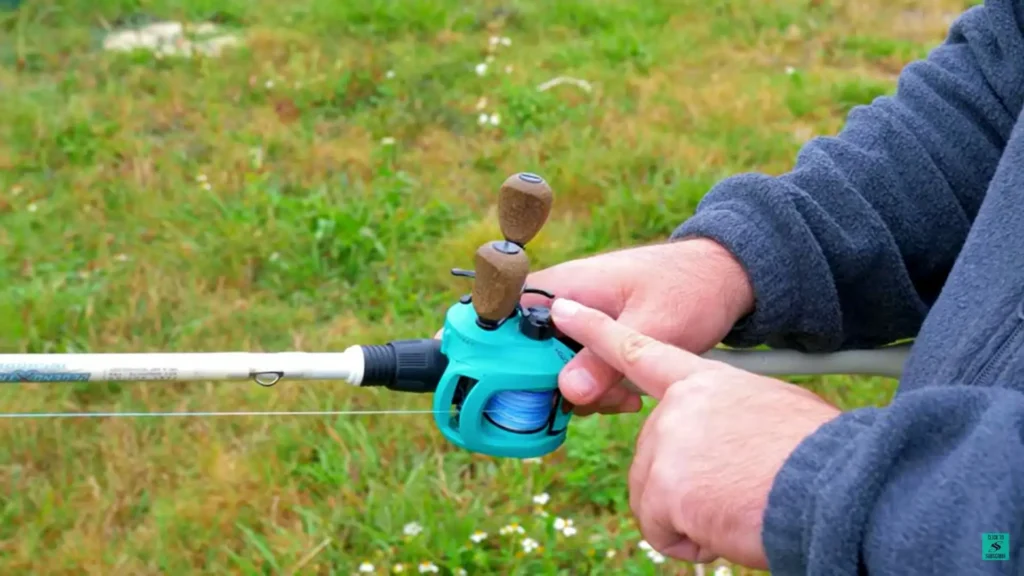
The first thing you will concentrate on is the tuning procedure. During this process, you will be changing the tension knob and brake mechanism to control the spool speed for various types of fish. Begin by tightening the tension knob and gradually loosening it as you gain experience.
Adjust the brake system as most bait-caster reels have adjustable brakes that allow you to control the speed of the spool. For beginners, set the brakes to a moderate level.
Step#2
With your dominant hand, grasp the bait-caster rod handle firmly. Remember that your grip should be comfortable for you.
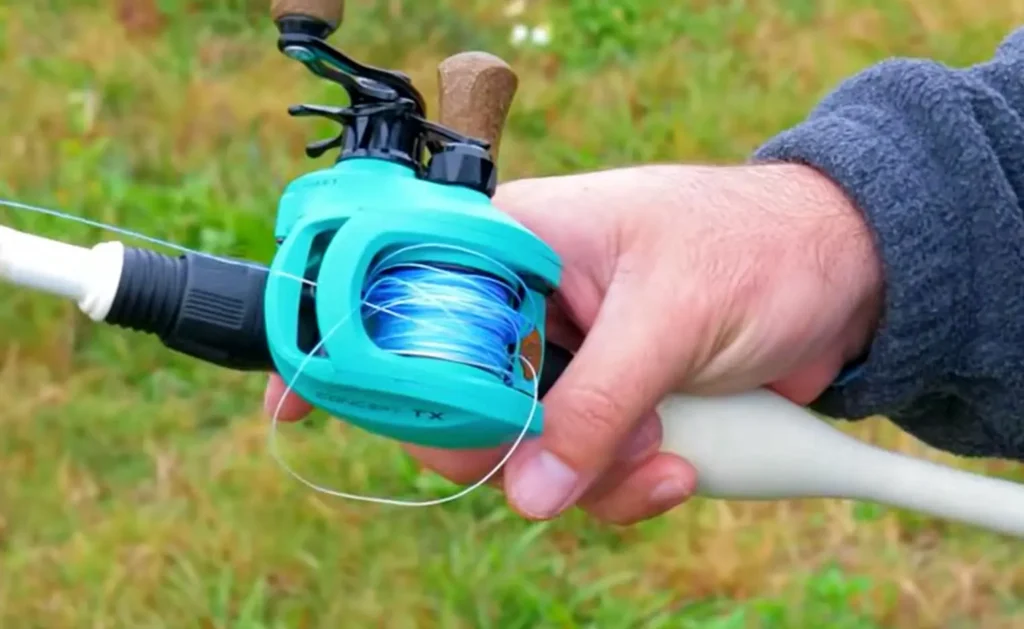
Step#3
To manage the line’s release during the cast, place your thumb lightly on the reel’s spool. While casting, your thumb works as a brake to prevent backlash (tangled line). When adjusting your rod, keep in mind that when your line is released and it touches the ground, it should not form a bird’s nest on your spool. If a bird’s nest forms, reposition your rod.
Step#4
Typically, when casting, the first thing you should do is, let your lure drop 8-10 inches from the rod tip. This technique works better since you will be leveraging the lure and its momentum to form the arc, which will provide you with a nice fishing experience. Position yourself with your feet shoulder-width apart, facing your target area. At a 45-degree angle, point the rod tip downward and to the side.
Step#5
This is the most critical step because you will always be thumbing the spool when casting. To keep the line from shifting, place your thumb against the spool. Swing the rod tip up and down in a smooth, controlled motion to develop velocity. Release your thumb pressure as the rod tip approaches eye level, allowing the line to begin spooling out.
Step#6
Keep your thumb softly in touch with the spool as the line begins to spool out to control the speed. If you are a newbie, avoid overhand casting because it might break the rod or lead to the formation of a bird’s nest. The sidearm cast is the right way to release. Because it improves the smoothness of the fishing experience and avoids the formation of bird’s nests. The next thing you’ll do is direct the rod tip towards your target area and keep moving ahead. Just before the bait or lure touches the water, completely release your thumb.
Step#7
Practice until you’ve mastered it. Bait casters might be more difficult to cast without backlash, particularly for beginners. Begin with modest casts and work your way up to longer distances as you build confidence and control. Pay close attention to any backlash (tangled line) and adjust the brake system or tension knob properly to avoid it.
Note: To develop the essential muscle memory and control while casting with a bait caster, practice and patience are required. Expect a learning curve, but with time and practice, you’ll improve your accuracy while casting with a bait-caster rod.
Casting with a spin-caster:
Before you start with your spin casting practice, I will recommend you start in an open area such as a park or any quiet part of the riverbank.
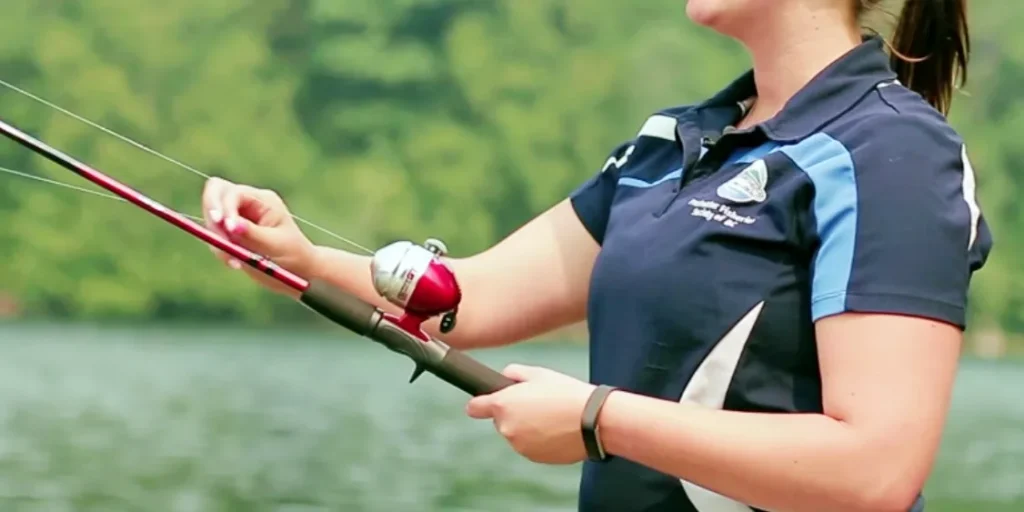
Step#1
Prepare your gear. Choose the appropriate bait or lure. Know the type of fish you are targeting so choose accordingly.
Step#2
Make use of both of your hands. Your dominant hand should be holding the spincasting rod whereas your non-dominant hand should be on the handle.
Step#3
Adjust the drag system of your reel. The drag varies according to the strength and type of the fish you are targeting. So, set it accordingly.
Step#4

On the back of the spin casting reel, you will find a small button or trigger which will be just above the handle. Locate that button and hold it down with the help of your thumb. This way you can disengage the line pickup and the fishing line flows smoothly.
Step#5

Now position your rod slightly downward and away from your body at an angle of 45 degrees. Swing the rod tip backward in a smooth and controlled motion to load the rod. This motion is important as it helps in building up the energy for the cast.
Step#6
When you are ready to cast, you have to aim your rod towards the target area. Release the button that you were pressing, so that the line starts spooling out smoothly. Now you have to continue the forward motion of the rod and point it in the direction of your target. The bail, lure, or hook will carry the line to the desired location.
Step#7
Once you see that your bait or lure is in the water, engage the reel by turning the handle. This way your line will stop from spoiling and you will be able to retrieve it.
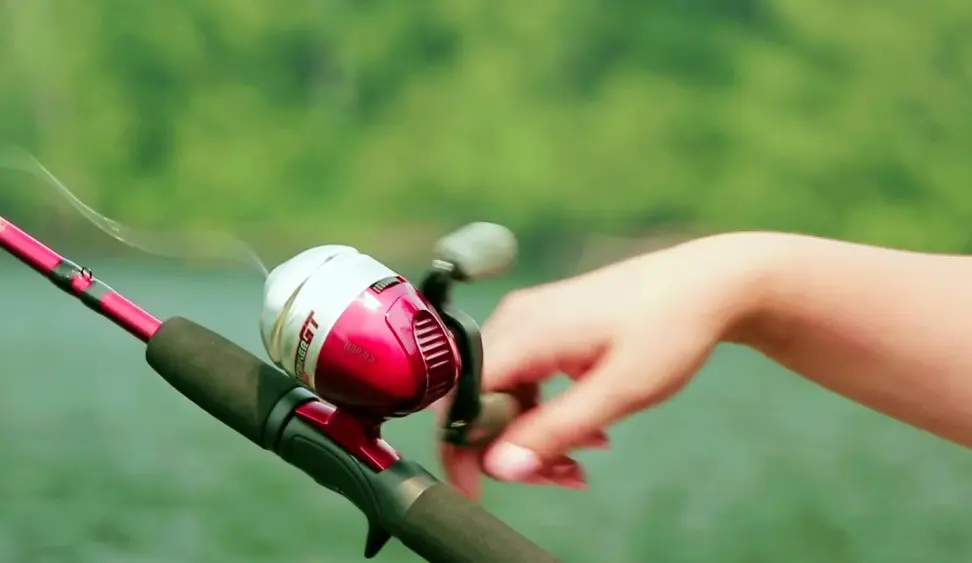
Casting with a surf rod:
Casting a surf rod is a surf fishing ability in which you cast your bait and lure from the shoreline into the water. Here’s a general guide to casting a surf rod:
Step#1
You should select the appropriate surf rod and reel. Make sure you have a surf-specific rod and reel set up for long-distance casting in saltwater.
Step#2
Make sure you use the right bait and tackle for the sort of fish you’re after and the surf conditions.
Step#3
Make sure your rod and yourself are appropriately positioned. Hold the rod away from your chest or below your chest. You should face the ocean and stand with your feet shoulder-width apart. Depending on your desire, face the water with your dominant side (right or left).
Step#4
Grip the surf rod with both hands, your dominant hand around the reel seat or at the bottom of the rod, and your non-dominant hand further up the rod for stability. This will make guiding the rod easier and provide better precision while casting. Your body should be up and out, and your rod should be cast at a 45-degree angle.
Step#5
To allow the line to run freely, open the bail or release the line on your reel. Before you throw your rod out, make sure not to pull the line out with your hands, as this might cause the drag to loosen, your finger to be cut, and bleeding to occur. Before you handle the braid, make sure to tighten the drag so that you don’t draw up the line at all.
Step#6
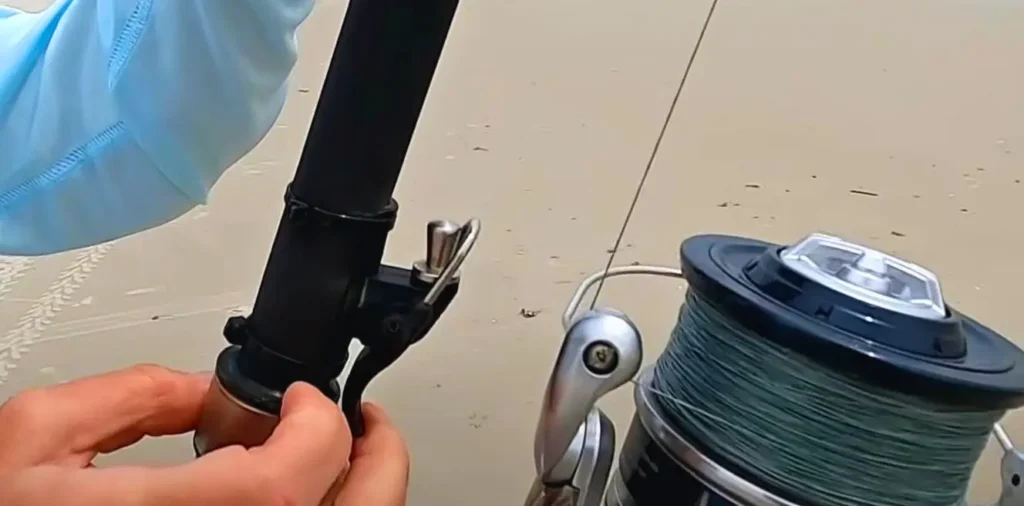
For this step make sure your rod has a cast cannon installed. To use the casting cannon, press the trigger out, wrap your line twice around the trigger knob and squeeze the trigger. Simply open your bail and let go of the trigger when you’re ready to cast.
Step#7
Swing the surf rod back behind you, gaining momentum. Transfer your weight from your rear foot to your front foot and rotate your hips and shoulders towards the target location as you begin your forward cast.
Step#8
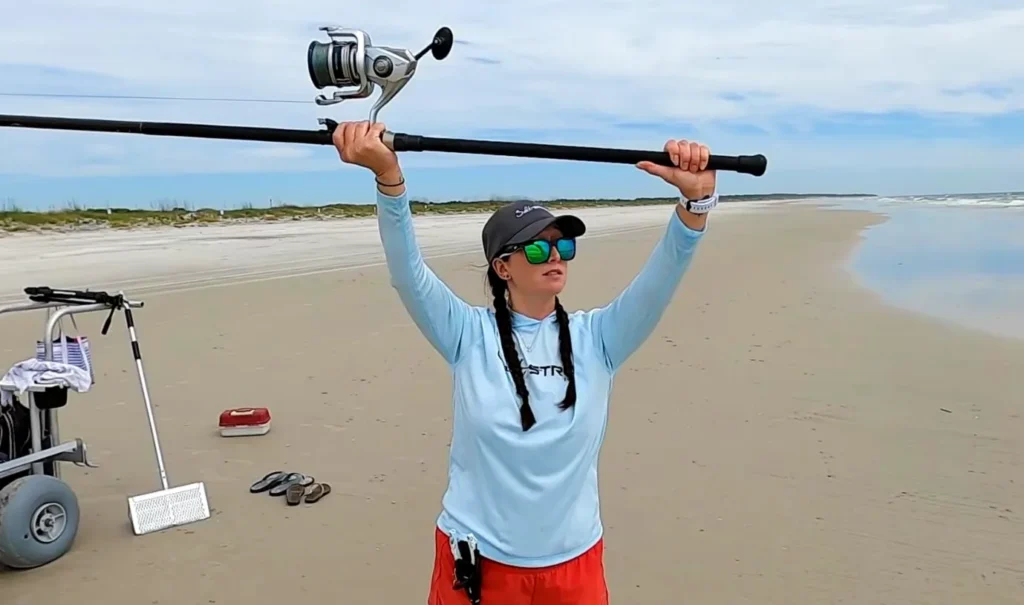
Release the bait or lure as the rod tip approaches a high point during the forward cast to allow it to be carried by the momentum of the cast. To get the most distance, completely extend your arms.
Step#9
Continue the forward motion of the rod after releasing the bait or lure, pointing it in the direction of your target region.
Step#10
When your bait or lure lands in the surf, engage the bail of the reel or begin reeling in to remove any slack in the line.
Step#11
Keep an eye out for bites or nibbles on your line. When you feel a bite, set the hook by pushing the rod tip up quickly and forcefully.
Note: Remember that surf casting can be physically taxing, and that long, accurate casts require practice. Keep an eye on the wind and wave conditions, as they might have an impact on your casting distance and accuracy. You’ll improve your surf casting talents with time, increasing your chances of catching fish in the surf.
Casting with a fly rod:
Casting a fly rod is a distinct fly-fishing method. Here’s a simple guide to casting a fly rod:
Step#1
Select the Proper Fly Rod, Reel, and Line. Choose the right fly rod, reel, and fly line for the sort of fish you’re after and the conditions you’ll be fishing in.
Step#2
Understand the Fundamentals. Fly casting involves propelling the lightweight fly with the weight of the line rather than the weight of the lure or bait. The forward cast and the back cast are the two main styles of fly casting.
Step#3
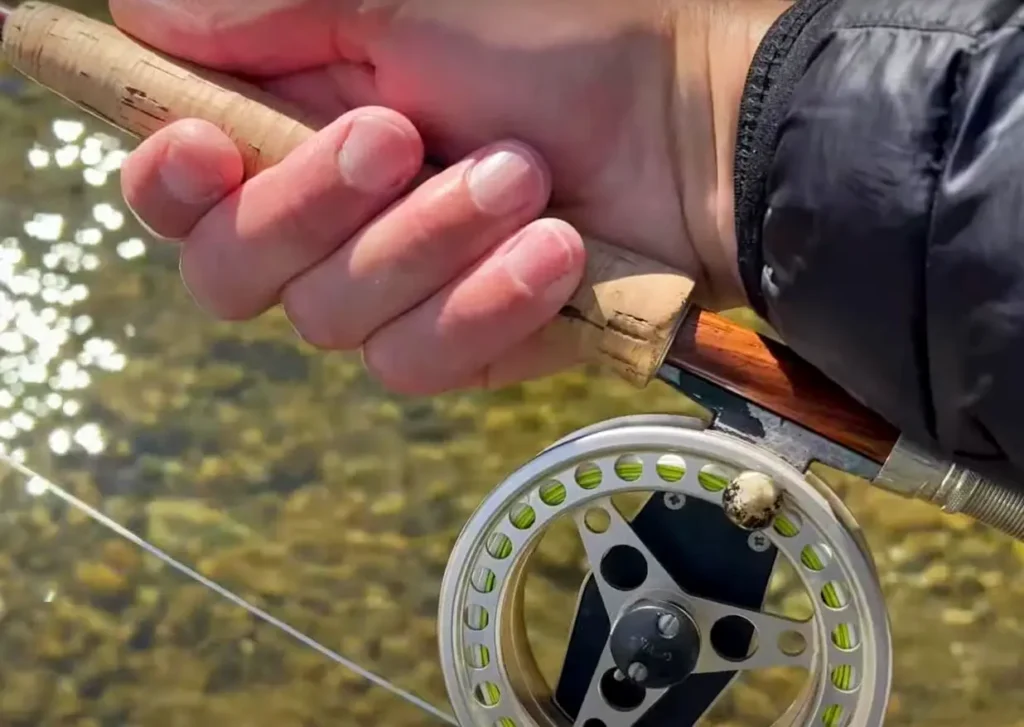
The proper technique to hold a fly rod. You can create a comfortable grip by placing your dominant hand above the reel and your non-dominant hand above it. Another method is to hold the rod with your dominant hand and place your non-dominant hand on the handle just above the reel, forming a grip known as the “thumb on top” technique. In this technique, your thumb is supposed to rest on the top of the rod handle, while your fingers curl around the underside.
Step#4
The next step is to decide on the length of the line you wish to utilize. Begin by stretching the majority of the fly line and leader (a tapered portion of the line) outside the rod tip and in front of you.
Step#5
Get ready to cast. Stand with your feet shoulder-width apart, facing your target area. Hold the fly rod with the rod tip pointing up and your line hand softly gripping the line. When back-casting with your rod, make sure to smoothly accelerate the rod in a controlled motion, allowing the fly line to extend behind you.
Step#6
The fundamental casting action would be to begin with a back cast and mentally move to the back at around 10 o’clock. Move the rod tip backward smoothly, creating a little bend in the rod. Accelerate the rod tip and take a brief pause when it is behind you.
Step#7
Continue with a forward cast. Similarly, to the back cast, mentally move to the front at about 2 o’clock. Then, in a straight line, accelerate the rod tip forward. Stop the rod tip abruptly in the desired direction of the line.
Step#8
The next thing to remember is to be patient and take your time. Casting should not be done too quickly. A successful fly cast requires precise timing and speed. Both the back and forward casts should be in harmony. But bear in mind that you want to perform like a clock’s pendulum when you backcast. Which is neither too quick nor too slow, but exactly right.
Step#9
Keep an eye on the queue. During the cast, keep an eye on the fly line as it unrolls behind and in front of you.
Step#10
Repairing the line. Following the forward throw, you may need to fix the line on the water to ensure the fly drifts naturally. This entails raising or moving the queue.
Step#11
Think about the wind and the obstacles. The wind might have an impact on your casting technique, so modify it appropriately. Keep an eye out for obstructions behind you, such as trees or bushes, that could interfere with your back cast.
Step#12
Discover Different Casting Techniques. You can experiment with numerous casting tactics as you gain skills, such as roll casting, sidearm casting, and others.
Step#13
Practice and practice until you have it correctly. Fly casting is a skill that takes time to master. Begin with short casts and gradually improve your casting distance and accuracy.
Note: Fly casting might be difficult to master, but it is a rewarding skill for those who appreciate the sport of fly fishing. Patience and practice are essential when learning to cast a fly rod.
What is the easiest reel to cast?
We know that there are three primary styles of casting reels which are spinning, baitcasting, and spinster respectively. Among these three, spin cast reels are the easiest to learn and simplest to operate while casting. One feature of spin cast reels is that the spool that has the fishing line is completely enclosed within the reel.
If your right hand is dominant:
Your dominant hand is used to control the casting motion. Your right hand should be the one responsible for reels and line control. Make the most out of the strength of your right hand. You can engage your right arm, shoulder, and wrist to maximize casting distance and accuracy.
If your left hand is dominant:
In this case, your right hand will control the fishing rod and reel. Your left hand will be responsible for executing precise casting motions. Focus on generating more casting power and accuracy with the help of your left hand. However, having a different dominant hand won’t affect your performance.
Different techniques for casting

Now that you are aware of different rods and reels and how you can cast with them, let’s move towards the different techniques that you can make use of during casting.
Overhead Casting:
This casting technique is among the basic ones and is widely used for various fishing styles. In this, you have to hold your rod with both hands while pointing the rod tip upwards. Then, simply cast the bait or lure overhead. When you are looking to cast for long distances, this technique is ideal.
Sidearm casting:
This technique is known for its versatility and is used mostly when the overhead space is limited. For this, you have to hold the fishing rod to the side, making it parallel to the ground. Then cast your bait or lure in a horizontal direction. When you have to avoid overhanging trees and bushes, this technique is very useful.
Roll casting:
When it comes to fly fishing, this technique is very common. For this technique, you have to cast the line by making a rolling motion with the help of the rod tip instead of using the traditional backcast and forward cast. This technique is also very useful when the space around is limited.
Pitching:
This technique has a closed range and is known for accuracy. For this technique, you have to swing your fishing rod to your side and then release the bait using an underhand motion. When the space is right or the surroundings are filled with heavy covers or you have to fish under docks, this technique is suitable.
Flipping:
This technique is widely known for precision casting and is used in close-quarters fishing. In this, you have to drop the bait or lure straight downwards from an elevated position. Then you have to lift the rod tip to swing it towards the target. This technique is very effective when you are looking for precise placement in dense vegetation.
Skipping:
If you are looking for a technique to make your lures bounce, then this is the ideal one for you. For this, you have to cast at a low angle and aim for the surface of the water. Do it in a way that it causes the bait or lure to skip and imitate a fleeing prey. This way you can effectively attract predatory fish.
Underhand casting:
This technique is ideal for small lures and lightweight tackle. For this, you have to cast with an underhand motion. Keep the fishing rod low and parallel to the water during this. Anglers use it often when they are fishing for panfish in calm waters.
Trolling:
This casting technique is done from a moving boat. You have to cast lures or bait while the boat moves. Typically the boat motion is slow. Anglers use this technique commonly for species like salmon or lake trout.
Mistakes you should avoid during casting
There are a lot of common mistakes that anglers, especially beginners often make. They should be avoided if you want a successful and frustration-free fishing experience.
1) Some anglers go for overcasting which means casting too forcefully leads to a backlash, tangles, and even snapped lines. To avoid this, use an appropriate amount of force based on the weight of your bait or lure. You can also avoid this by practicing smooth and controlled casting motions, rather than relying completely on power.
2) Poor timing is also a common issue. Anglers fail to release the line at the right moment during the cast which results in short casts and tangles. To avoid this mistake, you have to work on your timing and coordination between the forward motion of the rod and the line release. Better practice can help you develop a sense of when to release the line.
3) If you cast directly into a strong headwind, this will result in a very reduced casting distance. So, whenever it is possible, try positioning yourself to cast with the wind at your back. Also, adjust your casting angle to minimize the impact of wind.
4) If you hold the rod too tight or with an incorrect grip, you will reduce the casting accuracy and sensitivity. To avoid this, maintain a comfortable grip on the rod. You should be able to sense subtle movements through your grip.
5) If you fail to manage your fishing line properly, you will face a decreased casting distance along with line tangles and knots. To avoid this, make sure that you are keeping your line taut. Avoid the line from getting dragged in water and periodically check for knots and twists. Proper line management is a crucial aspect.
6) Do not ignore the rod action. If it doesn’t match with your gear, you will face poor performance. Make sure that you have selected the right rod action for the right species.
7) If there isn’t enough casting space behind you, you might end up hooking trees, bushes, and other obstacles. Make sure that you always have sufficient space for backcasting.
8) If you neglect the drag adjustment on your reel, you can lose a fish or you will have to deal with snapped lines. To avoid this, always make sure that the drag is set appropriately based on the size and strength of the fish that you are about to target.
Final words
Finally, I will say that casting is a crucial aspect of fishing. However, it isn’t a very difficult thing to deal with. You will have to invest some effort in patience and practice. If you are consistent with your efforts, you will learn it in no time.
